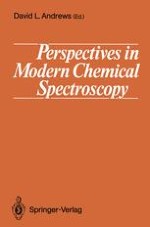1990 | OriginalPaper | Buchkapitel
Electron Paramagnetic Resonance and Electron Nuclear Double Resonance Spectroscopy
verfasst von : A. J. Thomson
Erschienen in: Perspectives in Modern Chemical Spectroscopy
Verlag: Springer Berlin Heidelberg
Enthalten in: Professional Book Archive
Aktivieren Sie unsere intelligente Suche, um passende Fachinhalte oder Patente zu finden.
Wählen Sie Textabschnitte aus um mit Künstlicher Intelligenz passenden Patente zu finden. powered by
Markieren Sie Textabschnitte, um KI-gestützt weitere passende Inhalte zu finden. powered by
An unpaired electron can be aligned by an applied magnetic field so that its spin is precessing about the field. The direction of spin precession can be either clock- or anticlockwise corresponding to the two energy states of the electron (Fig. 1). Irradiation with an electromagnetic beam of the correct frequency can induce transitions of the unpaired electron from one spin direction to the other. The transition is induced by the oscillating magnetic field component of the electromagnetic radiation. Thus the transition is a magnetic dipole process and consequently the selection rule for the transition is that the spin component along the direction of the applied field, given by Ms, must change by ± 1 unit. The energy equation for resonancee is the well-known expression ${\rm h}v_0=g\mu_{\rm B}{\rm B}_0$ where g is the splitting factor, μB the Bohr magneton and B0 the applied field. For a magnetic induction field of 0.33 T and a g-factor of 2.0 the microwave energy, hv0, is 0.3 cm−1. A resonance spectrum is obtained by placing the sample in a microwave cavity tuned to the frequency of the microwave radiation. An external magnetic field is applied and swept until the resonance condition is found.
